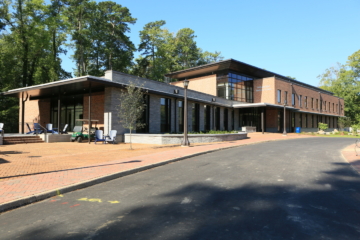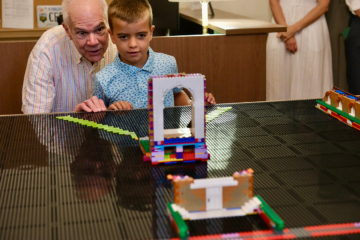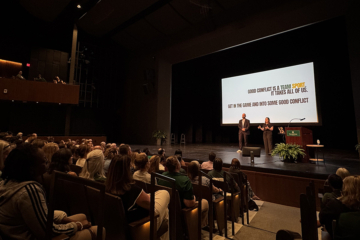‘A homecoming deferred’: W&M Bray School Lab hosts Descendants Week 2025
In late April, the William & Mary Bray School Lab hosted its fourth annual Descendants Week, a gathering that brought together members of the Williamsburg Bray School Descendant Community and the broader public for a week of reflection, sharing, research and reconnection.
Like last November’s landmark re-dedication of the Williamsburg Bray School building, Descendants Week is, annually, seen by members of the Descendant Community as a homecoming.
The W&M Bray School Lab comprises part of Strategic Cultural Partnerships at W&M, under the leadership of Ann Marie Stock, presidential liaison for strategic cultural partnerships. Formed as part of the Williamsburg Bray School Initiative, a ground-breaking partnership with the Colonial Williamsburg Foundation, the W&M Bray School Lab researches the history and legacies of the Williamsburg Bray School – with a special focus on the students who studied there and their descendants.
“When we began to craft a vision for what Strategic Cultural Partnerships and the W&M Bray School Lab would be, we knew we would make discoveries and share new knowledge,” Stock said. “ What we couldn’t have imagined were the extraordinary relationships that would develop in that process. In partnerships with so many others we have built bridges across divides, and advanced in very tangible ways reconciliation and understanding.”
The week’s events, ranging from a recorded public lecture to be broadcast as part of C-SPAN’s “Lectures in History” series, to a family history celebration, offered spaces where the past met the present, and where new voices joined a tight-knit but growing community.

Among those voices was 81-year-old Loretta Burwell, who climbed into her red pickup truck and drove from Atlanta to Williamsburg to be part of the gathering. Her drive signified much more than the nine hours north bound on I-85; it was the next step in an extraordinary journey home, a leap of cartographical faith.
“Ms. Burwell is tenacious,” said Bray School Lab Director Maureen Elgersman Lee. “And her tenacity invites us to be more tenacious as well. it’s infectious.”
The story of Burwell’s involvement with the lab began in a library in Mecklenburg County, Virginia. In early 2024, Elizabeth Drembus, Bray School Lab genealogist, and Tonia Merideth, oral historian, were conducting research on the students who attended the Williamsburg Bray School between 1760 and 1774.
Drembus and Merideth describe their research as sometimes walking in the borderlands of an incomplete map. With only three surviving student lists and some eighty known names out of an estimated 300 to 400 children, the work is painstaking and often uncertain – an act of faith that the ancestors will reveal the path when the time is right. They were deep in the borderlands that day in the Mecklenburg County Library, lost and frustrated. Genealogical research is like that sometimes.
Until.
A yellowed index card appeared in a file, requesting help researching the Burwell family, a family known to Drembus and Merideth as enslavers who had sent children to the Williamsburg Bray School. The card, dated some 30 years earlier, included an address.

The address led to an email. Some typing. Hopeful questions. Crossed fingers.
And an answer. That card was left by Loretta Burwell. New coordinates on the map.
“She got in her red truck and drove all the way from Georgia. She brought notebooks of all her research. She was amazing and generous with her time,” Merideth said. “She didn’t tell her children she was doing this.”
Burwell’s arrival in Williamsburg was met with warmth and curiosity. She attended every event, from the Monday night lecture by Maureen Elgersman Lee at the newly renovated Muscarelle Museum of Art, to be broadcast by C-SPAN, to the Saturday afternoon family history celebration at Bruton Heights School. At each stop, she shared stories, asked questions, offered wisdom, told jokes.
She was “embraced wholly” by the other members of the Williamsburg Bray School Descendant Community, said Merideth. “There were tears. There was laughter. It was like welcoming family.” A reunion – a homecoming.
On Friday evening, the annual Descendants Week reception at Travis House brought together a remarkable mix of people: descendants of Bray School students, descendants of enslavers, researchers, W&M faculty, staff and students, and community members. In that space, Burwell met Susan Antenen, a white descendant of the same Burwell family line who had made her own journey from New York to participate in the week’s events. The two women talked for hours, sharing genealogical notes and family stories, bridging centuries of hard history with grace, civility, and curiosity, two family lines converging on a shared map.
There’s no map for navigating difficult conversations, fraught with years of injustice and distrust – not a complete one, anyway. Terrain shifts, fissures form. “They talked the entire night,” Merideth said. “They were both so excited to meet each other. It could have been an uncomfortable situation, but it wasn’t.”
By creating space for Descendant Community voices, the Bray School Lab is not only advancing scholarship of consequence, it is revealing new paths on the map, surveying new landscapes, creating new legends, and narrowing the borderlands by expanding the narrative of American history to include those whose stories have too often been left out.
“It was healing,” Merideth said. “That’s how we heal from trauma – by having conversations.”
Saturday’s events included a panel moderated by Janice Canaday, Descendant Community member and African American community engagement manager at the Colonial Williamsburg Foundation, where Burwell joined Mildred Walker and Carol Miller, assisted by her son Burnell Irby, other members of the Descendant Community, in sharing reflections on resilience, family and legacy. Though the panel was not formally recorded, its impact was profound.

“It was simply these three wise women,” Drembus said. “They talked about what it means to carry forward the stories, the values, the strength of those who came before. Miss Loretta even read a poem she had written. It was magical.”
Burwell’s visit to the Bray School building itself was especially moving. She was given a private tour of the preserved structure by partners from the Colonial Williamsburg Foundation, where she stood on the restored original floors. “This history is her history,” Elgersman Lee said.
The team at the W&M Bray School Lab is still working to chart Burwell’s family lineage from the 1700’s until today – less a straight line and more a winding path through memory, archives, names. The team navigates this terrain with a compass of family materials, oral histories, personal notebooks, partnerships – and, sometimes, 30-year-old notes neatly typed on index cards in libraries. The map evolves, information is integrated, borders get re-drawn, new communities develop.
With Descendants Week 2025, Elgersman Lee said, William & Mary, Strategic Cultural Partnerships and the W&M Bray School Lab “exemplified belonging. And by doing that, we had it given back to us. When I see (Burwell) again, it won’t be as a guest. It’ll be as a friend.”
Descendants Week 2025 was a week of many kinds of moments, each one distinct – a lecture, a town hall, a reception, a panel, a moment of laughter, of tears, of conversation – and of quiet reflection. “There was such a quiet power in those encounters,” Drembus said. ”Look at this space that has been created. Look at what’s possible when we come together.”
In those spaces, the Bray School Lab modeled what it means to be of service to the public good: a place where research and relationship-building go hand in hand, where national connections are forged through local stories, where the past is not undiscovered country but a bridge leading in new directions.
The Williamsburg Bray School is scheduled to re-open as the 89th original Colonial-era building in the Historic Area of Colonial Williamsburg in a ceremony co-hosted by William & Mary and the Colonial Williamsburg Foundation on Thursday, June 19, 2025 – Juneteenth, commemorating the ending of the practice of enslavement in the United States of America. Because of the generosity of the Andrew W. Mellon Foundation and the Commonwealth of Virginia, key partners in the restoration and research of the building and its students, access to the building will be free in perpetuity.
Burwell “wasn’t able to attend the building’s dedication in November,” Elgersman Lee said, “so this was her moment.”
The ancestors spoke. A path revealed. “I came to honor them,” Burwell said. “I am the future they dreamt of.”
“It was powerful,” Elgersman Lee said. “It was a homecoming deferred.”
Now realized.
Latest W&M News
- Student Health Center continues exceptional student care with AAAHC reaccreditationAAAHC accreditation, held by only seven universities in Virginia, recognizes the university's commitment to providing exceptional student-centered care.
- Brick by brick: W&M community to build model of its Historic CampusWilliam & Mary has launched a yearlong project to build a Lego model of its Historic Campus with the help of students, faculty, alumni and the Williamsburg community.
- Finding meaning in the danger zoneDavid Long explores how near-death experiences transform work through storytelling.
- Conflict as a catalyst for growth: W&M’s 2025 Professional Development DaysWilliam & Mary’s second annual Professional Development Days focused on navigating conflict.
- Energy sector leader Darpan Kapadia ’95 to speak at Opening ConvocationDarpan Kapadia ’95 will welcome new William & Mary students this month at Opening Convocation.
- Strategic Cultural Partnerships Faculty Fellows reshape America’s founding story as 2026 approachesEight W&M faculty awarded SCP fellowships to enrich historical narratives and strengthen civic leadership ahead of nation’s 250th anniversary.













